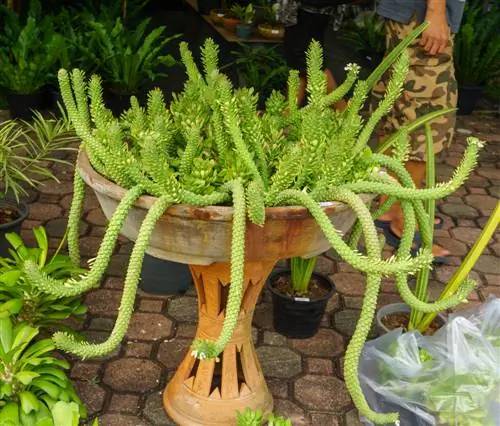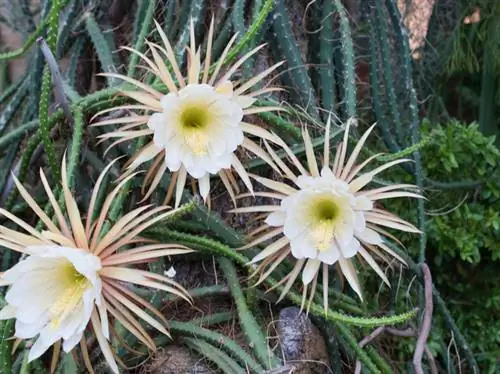- Author admin [email protected].
- Public 2023-12-16 16:46.
- Last modified 2025-01-23 11:22.
Read a commented snake cactus profile here with explanations of growth, flowers and known species. You can find out how to propagate Aporocactus flagelliformis through cuttings, plant it correctly and care for it here.

What is a snake cactus and how is it propagated?
The snake cactus (Aporocactus flagelliformis) is a hanging, succulent plant from Mexico that produces pink-red, funnel-shaped flowers. This easy-care plant is particularly suitable as a houseplant or hanging basket plant. To propagate, cuttings are cut and planted in a cactus soil and sand mixture.
Profile
- Scientific name: Aporocactus flagelliformis
- Family: Cactaceae
- Genus: Aporocactus syn. Disocactus
- Synonyms: whip cactus
- Origin: Mexico
- Growth type: Succulent
- Growth habit: hanging, creeping
- Growth length: 60 cm to 80 cm
- Flowers: funnel-shaped to tubular
- Leaves: Thorns
- Winter hardiness: not hardy
- Use: houseplant, hanging plant
Growth
Snake cactus is a Mexican cactus species from the genus Aporocactus. Alluding to the hanging growth, the suffix “flagelliformis” means whip-shaped or tendril-shaped. The exotic cactus plant is also known under the synonyms whip cactus and Disocactus flagelliformis. Beginning hobby gardeners appreciate Aporocactus flagelliformis as an easy-care houseplant. Traditionally, a snake cactus rounds off every cactus collection with these extravagant growth characteristics:
- Growth type: Cactus with slender, thorny shoots, large, pink flowers and red berries.
- Growth habit: creeping or hanging.
- Shoot: rounded with 8 to 13 low ribs, closely spaced areoles with up to 20 yellowish thorns.
- Growth length: 60 cm to 80 cm, rarely up to 100 cm.
- Gardenically interesting properties: easy to care for, sensitive to frost, non-toxic, decorative, ideal hanging plant.
Flowers
The snake cactus decorates its bizarre hanging tendrils with these flowers:
- Flower type: Single flower
- Flower shape: funnel-shaped or tubular, rarely wheel-shaped.
- Flower size: 5 cm to 8 cm long, 3 cm to 4 cm wide (varieties up to 14 cm in diameter).
- Flower color: pink to purple.
- Flowering period: March to June (daytime).
Video: Snake cactus in full bloom
Species
In addition to the original species Aporocactus flagelliformis, the genus includes two other snake cactus species with license to be used as an ampelous plant. The following table lists similarities and differences:
| Species | Aporocactus flagelliformis | Aporocactus martianus | Aporocactus flagriformis |
|---|---|---|---|
| Trade name | Snake Cactus | NN | Snake Cactus |
| Synonym (German) | Whip Cactus | NN | Whip Cactus |
| Synonym (botanical) | Disocactus flagelliformis | Disocactus martianus | Disocactus flagriformis |
| Growth length | 60 cm to 100 cm | 100 cm to 150 cm | 60 cm to 100 cm |
| Drive diameter | 1, 2 cm to 2 cm | 2 cm to 2.5 cm | 2 cm to 3 cm |
| Flower color | purplepink | light red | pink |
| Flowering time | March to June | Spring and Summer | April to July |
Occasionally, cactus gardeners offer cuttings of the rare species Aporocactus malisonii as a snake cactus. In contrast to the protagonists in the table above, the ribs of the hanging shoots are more prominent in malisonii.
Planting snake cactus
In a cactus specialist shop you can buy a ready-to-plant snake cactus for a price of around 8 euros. In forums, generous hobby gardeners offer like-minded cactus friends inexpensive cuttings for propagation. The choice of location and planting technique do not pose any gardening stumbling blocks, even for beginners. Read here how and where to plant Aporocactus flagelliformis correctly:
Propagation
A snake cactus is easy to propagate through cuttings. The following instructions explain the correct procedure step by step:
- Best time is between April and August.
- Cut 10 cm to 15 cm long cuttings with a sharp, disinfected knife.
- Let cuts dry for two days.
- Plant cuttings upright 2 cm to 4 cm deep in pots with cactus soil and sand mixture.
- Let it root in a bright to partially shaded window seat at room temperature.
Keep the potting soil constantly slightly moist. Additionally, spray the cuttings with soft water several times a week. Drought stress and waterlogging are the most common causes when cactus cuttings do not grow.
Planting Tips
Purchased or propagated snake cactus is best planted in permeable cactus soil. A finger-thick drainage made of expanded clay on the bottom of the hanging basket or pot quickly drains away excess irrigation water. Robust leather gloves with cuffs are suitable to protect against the sharp thorns. A whip cactus comes into its own in the trendy hanging basket.
Location
A suitable location for a snake cactus can be quickly found in any living or working space. The extravagant cactus will be happy to keep you company outside during the warm season. A location indoors during the winter is mandatory for the frost-sensitive whip cactus. Read these important framework conditions for Aporocactus flagelliformis:
- All year round in a sunny to partially shaded location at normal room temperatures.
- Available from May to September on the balcony or terrace.
- From mid/late October to early March, preferably in bright, frost-free winter quarters.
- Temperature minimum: 10° Celsius.
To protect against sunburn, a snake cactus spends the first two weeks of May in a partially shaded to shady location before taking its place in the sun.
Excursus
Snake cactus for night owls
The cactus genus Selenicereus provides sleepless indoor gardeners with magnificent snake cactus species with nightly blooms. The 'Queen of the Night' (Selenicereus grandiflorus) presents itself majestically with 30 cm large flowers on up to 300 cm long, snake-shaped shoots with needle-fine thorns. The 'Princess of the Night' (Selenicereus pteranthus) opens its feathery, yellow-white flowers at dusk, which exude an intense scent.
Care for snake cactus
Snake cactus care is easy. A regular supply of water and nutrients is supplemented by species-appropriate overwintering and occasional repotting. Care tips worth knowing for Aporocactus flagelliformis as a houseplant and hanging basket plant:
Pouring
- Keep the snake cactus substrate evenly moist from spring to autumn.
- Rule of thumb against ball dryness and waterlogging: Watering is always done when the substrate has dried to a depth of 1 cm.
- Use predominantly clean, collected rainwater or decalcified tap water as irrigation water.
Fertilize
- Add liquid cactus fertilizer to the irrigation water every 2 weeks from March to September.
- Water with clear, soft water before and after fertilizing.
Wintering
All cactus species require a winter break to induce flowers. This premise also applies to the snake cactus. In the absence of suitable winter quarters, the whip cactus spends the cold season in the living room without any problem.
- Preparation: water more sparingly from September onwards, stop fertilizing from October onwards.
- Put away: from nighttime temperatures below 15° Celsius.
- Ideal winter quarters for flower formation: at least 16 weeks bright and cool at 10° to 12° Celsius.
- Winter care for cool winters: do not water, do not fertilize, spray occasionally.
- Optional winter quarters: in the heated living or working room on the sunny window seat.
- Winter care at room temperature: spray regularly, water sips every 3 to 4 weeks after a finger test.
Cutting
You don't have to cut the whip cactus. The only exception applies to taking cuttings. The correct procedure can be found in the quick guide above.
Repotting
- Repot the snake cactus every two to three years in fresh cactus soil.
- The best time is after the flowering period.
- A new planter's diameter is at most two finger-widths larger than the root ball.
- After repotting, a whip cactus is not fertilized for six to eight weeks.
Diseases and pests
Despite its sharp thorns, a snake cactus is not immune to diseases and pests. The following table draws attention to common malfunctions and their causes with tips for effective countermeasures:
| malicious image | Cause | Countermeasure |
|---|---|---|
| Brown, sunken spots | Focal spot disease (Gloeosporium) | Cut out stains, dust cut with charcoal powder |
| Brown shoot tips, reddish spore coating | Fusarium wilt (Fusarium verticillioides) | Cut off the infected, repot, spray with lapacho tea or field horsetail solution |
| Webs between the rungs | Spider mites | shower, put in a plastic bag for a week |
| Woolly, bumpy surface | Mealybugs, mealybugs | isolating, dabbing with alcohol-soaked cotton swabs |
| Brown spots, soft shoots | Waterlogging | repot, water more sparingly from now on |
| Brown shoot tips | Drought stress | immersion in rainwater, water more regularly |
Popular varieties
These beautiful snake cactus varieties impress with their picturesque flowers:
- Rolf's Beautiful: Aporocactus flagelliformis hybrid impresses with larger, more colorful flowers than the pure species.
- Giant: Snake cactus with shoots up to 300 cm long, 2.5 cm thick and impressive pink-red flowers.
- Angela Paetz: Aporocactus random hybrid blooms with bell-shaped, orange-carmine-purple flowers from May.
- Rolf's Best: Aporocactus flagelliformis premium variety with red-purple funnel flowers and significantly wider petals than the original species.
- Fliedery Paetz: Magnificent whip cactus hybrid with up to 14 cm large, lilac-colored flowers from April.
FAQ
Which snake cactus species are suitable as hanging basket plants?
These snake cactus species are recommended for cultivation as hanging plants: Aporocactus flagelliformis, also known as Disocactus flagelliformis and Aporocactus flagriformis syn. Disocactus flagriformis with slightly thicker hanging shoots. Aporocactus martianus syn. Disocactus marianus differs from its conspecifics by hanging shoots with more pronounced ribs.
Where can you buy a snake cactus?
Purchasing sources for snake cacti are few and far between. We looked around for you and found what you were looking for at these specialist cactus dealers: Uhlig-Kakteen in 71394 Kernen with a nursery and online shop, Kakteen-Haage in 99089 Erfurt with a nursery and online shop. Cactus enthusiasts also occasionally offer snake cactus cuttings on Ebay and Amazon.
When and how often should a whip cactus be watered?
From spring to the beginning of autumn, large cacti, such as the whip cactus, are watered every 7 days in a sunny location. Before putting away the watering intervals are extended to 14 to 21 days. In cool winter quarters, stop the water supply completely. If you overwinter a snake cactus at room temperatures, check once a month using a finger test to see whether it needs watering. The cactus soil should not dry out completely.






